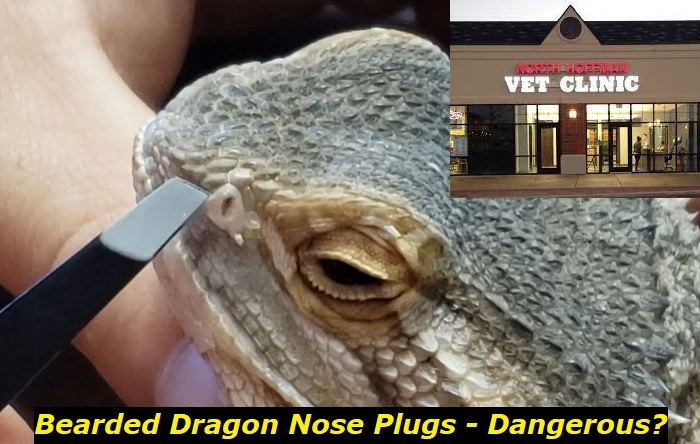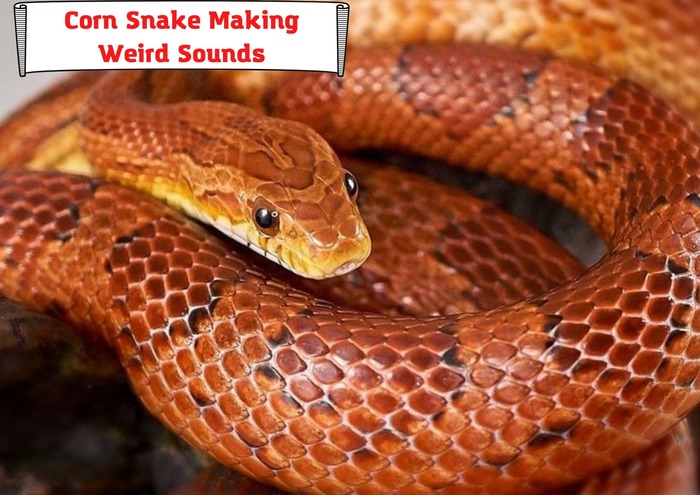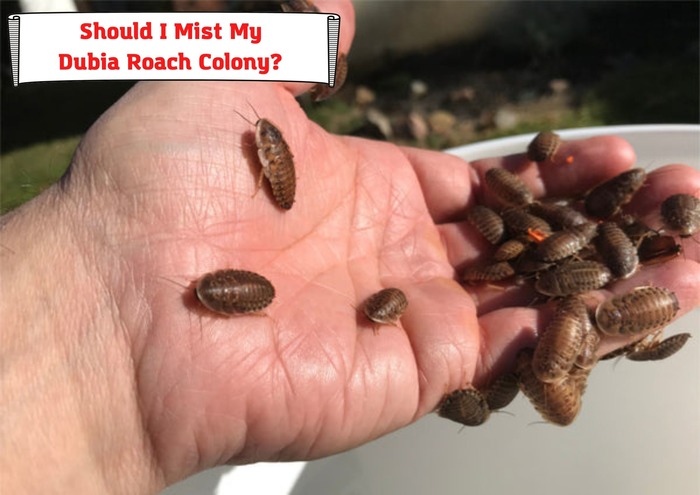It is not unusual to find new beardie owners freaked out about the dried nose plugs in their beardies’ nostrils. This is especially so when they find their pets wheezing or keeping its mouth open to breathe well.
Although you can remove the nose plugs by yourself, there are times when it would be best to consult a qualified herp vet.
Here is an article to help you understand what a bearded dragon nose plug is, whether to remove it or to see a vet. Read on to find out.

What Is Bearded Dragon Nose Plug
When newbies hear of a beardie’s nose plug, they often get confused. A bearded dragon’s nose plug is a recurring thing with bearded dragons. It is a piece of unshed skin that gets stuck in your pet’s nose after a shed.
It usually starts with a cap and extends into the nose like a long tube that runs into their nostrils, but it is no more than a piece of dry skin that is still unshed.
A nose plug is not a booger. It is dry skin that is only still unshed, in the bearded dragon’s nostrils.
Do You Remove It or Go to a Vet?
Yes, it would be best to remove it. In some bearded dragons, the beardie’s nose plug may hinder breathing and other functions of the nose. Beardies do not only rely on their nose to breathe. They also pick scents with their nose to understand their environment.
Normally when bearded dragons shed their skin, the appropriate humidity level in the enclosure helps them to take off the dead skin cells by rubbing their bodies off on the rocks and other decorative items.
While they may get off easy-to-reach pieces, it is usually difficult for them to get the nose plugs out. The reason is obvious; the dead skin runs into their nostrils and their nostrils are internal pathways that cannot be scratched against decorations in the enclosure.
While some bearded dragons may not experience breathing difficulty with their nose plugs in their nostrils, you may find others struggling to breathe. They will typically have their mouths wide open to gasp for air and even make a wheezing sound as they breathe.
To be on the safer side, it would be best to help your bearded dragon out by removing the nose plugs. Your bearded dragon will be better off breathing unhindered than when it had the nose plugs in its nostrils when you take out the nose plug.
How To Remove Bearded Dragon’s Nose Plugs
Unlike many other treatment procedures, removing bearded dragon’s nose plugs does not require soaking in a warm bath.
What you need is a pair of tweezers and a good light to take out the nose plugs from within your pet’s nostrils. Set your pet on a plane or a flat surface. Be sure to have it in a position where it will be stable.
Pick the end of the nose plug with a pair of tweezers. The nose plug usually starts with a cover over the nose opening. If you cannot pick the nose plug cover immediately, you want to separate it from the nose opening by first attempting to loosen it.
After loosening it, you want to hold the nose plug with a pair of tweezers. Usually, when you do so, your bearded dragon will instinctively move its head away from the tweezers, and the nose plug will come out free.
Repeat the same process with the second nose plug in the other nostril.
But if your bearded dragon does not move its head, you may have to gently remove the nose plug from your bearded dragon’s nostril by yourself. Gently drag out the nose plug.
The usual response bearded dragon owners get from their beardies when they remove the nose plugs is a feeling of relief. Your bearded dragon will start breathing freely again and if it was wheezing before, the wheezing will stop.
Do I Have to Go to a Vet to Remove the Nose Plug?
Although it is very rare, there are some times when removing nose plugs may cause injuries. This is a very rare occurrence as it is very unlikely to happen to a healthy bearded dragon. It is the reason some pet owners whose pets have severe overall health problems usually prefer to go to a vet.
However, whether your bearded dragon is healthy or not, you need to go to a vet immediately if your bearded dragon sustains injuries following the removal of the nose plug.
Apart from a bearded dragon with overall bad health, there are many other instances when you may need to take your bearded dragon to a qualified herp vet to remove the nose plug instead of removing it yourself.
A good instance is when your pet has just undergone a procedure. If your bearded dragon has just survived a recent surgery, especially a respiration-related surgery, it would be best to consult the herp vet.
Usually, the vet should tell you how soon your pet will heal and when you can remove your bearded dragon’s nose plugs. But if they forget to do so, you want to call or check back with the vet to know how safe it would be to remove the nose plug.
Other instances when it would be best to visit a herp vet include when your bearded dragon has a severe respiratory illness or injury. It would be best to check with your vet or take your bearded dragon to the vet to be sure whether to remove them or not.
Removing the nose plugs may or may not make the critical condition any worse. But since it will be better to be safe than sorry, checking with your vet will ensure that the decision to remove the nose plug does not make the injury any worse.
The vet will usually examine the critter and make an informed decision based on an evaluation of your bearded dragon’s health. And in the process of removing it, if your bearded dragon’s condition worsens, the vet will know how best to handle the situation.
Not checking with a vet is dangerous. If your bearded dragon’s condition worsens, the time to get to the vet may not be enough to save your pet.
Can Bearded Dragon Breathe With the Nose Plug
In the wild, the nose plugs will usually dry off and fall out in time.
But in an environment where the elements are controlled, this may not happen anytime soon for the bearded dragon.
So it is reasonable to ask whether they can breathe with the nose plugs.
Yes, beardies can usually breathe with the nose plugs in their nostrils. The nose plug is nothing more than unshed dead skin cells on the walls of the nostrils. It barely affects their breathing.
However, there are exceptions because of age differences and environmental factors such as humidity and heat in the enclosure.
Some bearded dragons, especially younger beardies, usually find breathing challenging with the nose plugs. A probable reason may be the smaller airways. They are smaller with smaller airways. Bigger beardies usually have wider airways because they are bigger.
You will usually notice your young bearded dragon struggling to breathe if the nose plug makes it hard to. Depending on how much obstruction is caused by the nose plug, you will usually find the bearded dragon either making a wheezing sound while trying to breathe or having its mouth open to take some air.
You want to pay attention to these distress signs. They are symptoms to put you on notice that the nose plugs in your beardie’s nostrils are obstructing the airways of your pet.
Also, improper environmental conditions can make it hard for your bearded dragon to breathe with the nose plugs.
Generally, humidity affects hydration, and a hydrated beardie will shed better than a dehydrated beardie.
Humidity helps with the shedding as appropriate levels help to break the dead skin free from your pet’s body when it burrows or scratches off a rock.
Your pet should shed efficiently with the proper humidity levels. You want something in the range of about 30-40%.
This would mean the plugs will dry off well and fall off in due time without obstructing airflow. So your beardie would still breathe well with the nose plugs still intact.
But beardies in enclosures with the wrong humidity levels may find it challenging to shed properly. The improper shedding could lead to the nose plugs not drying off well and blocking your pet’s airways.
Final words
So, although beardies can generally breathe with their nose plugs in their nostrils, there are exceptions.
Some beardies may find it hard to breathe with the nose plugs because they are small and have small airways compared to other beardies. Some may also find breathing challenging because of the inefficient shedding caused by the improper humidity levels in the enclosure.
- Dubia Roach Egg Sack: How To Understand if It’s Healthy? - January 2, 2023
- How To Feed African Dwarf Frog While on Vacation? - December 26, 2022
- Baytril for Bearded Dragon: Here’s What You Should Know - December 19, 2022



